Suresh Kumar Chaudhary, Jatadhar Jha
Department of Science and Technology, Himalayan Institute of Science and Technology, Kathmandu, Nepal
Correspondence to: Suresh Kumar Chaudhary, Department of Science and Technology, Himalayan Institute of Science and Technology, Kathmandu, Nepal.
| Email: |  |
Copyright © 2022 The Author(s). Published by Scientific & Academic Publishing.
This work is licensed under the Creative Commons Attribution International License (CC BY).
http://creativecommons.org/licenses/by/4.0/

Abstract
The aim of this research is to assess the status of safety management in construction industry of Kathmandu district. This research will help to locate the factors that are responsible for compromising the safety of workers in construction sites of Kathmandu district and prepare the strategies that will minimize the risks. For this numerous research papers were analyzed and case study of different ongoing construction sites of Kathmandu district was carried out. Methodology was designed as per requirement of the study. The primary data were collected by medium of interviews, questionnaire survey and from the observations of construction sites. These primary data’s were analyzed and presented in the forms of charts, tables and simple descriptive statistics form. Everyday many peoples lost their lives and hundreds of them get injured while working on construction. The research shows that weak and unsatisfactory implementation of rules and regulations related to safety, negligence of government together with construction companies, unskilled manpower and profit generation motives of companies are the main causes of accidents in construction industry or sites. This research shows that most of the reported deaths are result of negligence of contractors. Most of workers are unaware about labor act and regulations. So, this study shows that implementation of safety rules and regulations on construction site is very compulsory which will minimize risks and injuries. The strategies followed in developed country can be adopted to form the basic guidelines that will help to manage safety on Nepalese construction sites. These guidelines will provide basic parameters for managing and restoring safety on construction sites.
Keywords:
Construction companies, Labor Act, Risks and injuries, Safety management, Unskilled manpower
Cite this paper: Suresh Kumar Chaudhary, Jatadhar Jha, Comparison of Risk Minimization Strategies in an under Construction Five Star Hotel in Kathmandu Valley, Nepal, Journal of Safety Engineering, Vol. 11 No. 1, 2022, pp. 1-8. doi: 10.5923/j.safety.20221101.01.
1. Introduction
Risk management comprises the integration of basic principles of risk policy, the establishment of a risk- consciousness as well as the organizational integration. It is an impetus for the risk management process and is responsible for the control of risks in full knowledge of the current risk situation (Diederichs, 2004). Risk is contextual. It arises in the context of a situation that exists or is likely to occur at some point in the future. The situation which most give rise to risks are those which involve us in engaging in activities, carrying out tasks, making commitments or entering into obligations (Bowen, 2005). According to (Pun, 2015), the Nepalese construction industry uses less mechanization and is more labor intense with weak safety regulations. Safety is the state of being "safe" (from French sauf), the condition of being protected from harm or other non-desirable outcomes. Anything that compromise safety of worker in site is safety issue. Safety and health is related to each other. Safety can refer to control of recognized hazards in order to achieve an acceptable level of risk and according to World Health Organization (WHO), occupational health deals with all aspects of health and safety in the workplace and has a strong focus on primary prevention of hazards. Safety management is an organizational function, which ensures that are safety risks have been identified, assessed and satisfactorily mitigated. The objective of safety management in the construction industry is to prevent human injury or loss of life and to avoid damage to the environment and to property. Human errors are identified and analyzed by human error analysis (HEA) method which is used for risk assessment. Construction safety is no longer related to technical issues in the construction site. The construction project is one of the most dangerous and risky fields of work, where it is surrounded by many uncertainties that require management due to the presence of many internal and external factors that affect the process. In the year 2017, deaths due to all injuries combined were estimated to be 4.5 million worldwide (Z, 2020). Risk management is an important tool and forms part of the decision-making process in the construction industry (Salem, 2021). The purpose of construction risk management is to increase the probability and impact of positive events and decrease the probability and impact of negative events, which can be harmful to the project (Salem, 2021). Though Nepal is agriculture-based country, it has started shifting to concrete world with modern advancement. One in every five people who had jobs in Nepal, were employed in agriculture, the biggest employing industry. About 80 percentages of people used to work on agriculture which has dropped down to 63.21% which shows that it has just shifted to construction industry. Nepalese Construction industry contributed around 10 to 11% to GDP and 60% of the nation's development budget is spent through the use of contractors. Construction industry had the third largest share of employment. Globally as a result of poor occupational health and safety more than 2.78 million people die per year. In developing countries, the risk of having work related injuries is 10 to 20 times higher than that of developed countries because construction industry does not meet the minimum standards and regulations set by WHO and ILO for occupational health and safety. The construction industry as the economic prime mover and the bedrock of the survival of economies. Despite the immense importance of the industry in bringing about rapid growth and development, its activities have been confirmed to contribute to a very high level of accidents and fatality relative to other industries. Nepal is a developing country. The Global Burden of Disease (GBD) study estimated that 16 831 people (95% uncertainty interval 13 323–20 579) died from injuries in Nepal in 2017. The proportion of all deaths due to injuries increased from 6.31% in 1990 to 9.2% in 2017. According to GBD estimates for Nepal, disability-adjusted life-years attributed to injuries increased from 881 452 (668 625–1 049 545) in 1990 to 897 969 (718 350–1 092 186) in 2017, including 715 602 (540 423–894 816) years of life lost due to injury and 11.7% occupational injuries (Puspa Raj Pant, 2021). The objective of this research is to compare and identify status of safety management practices, working condition, risks, hazards, human errors and risk minimization strategies of five star under construction hotels in Kathmandu valley, Nepal. Moreover, key risk management strategies that are highlighted in this study will be beneficial for the hotel construction stakeholders.
2. Materials and Methods
2.1. Study Area
The research was conducted in Kathmandu district. Hyatt palace block B Solti mode, Sheraton Kathmandu hotel, kantipath and Hilton Hotel, Naxal Kathmandu are the three under construction five star hotel are selected for the research. Large number of involvement of Skilled workers and easy accessibility of site management team are main purpose of selecting these construction sites. Table 1. Salient features of 5-star under construction hotel under study
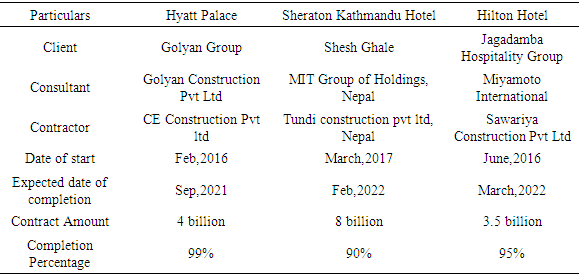 |
| |
|
2.2. Methodology
Research methodology is the path through which researchers need to conduct their research. It shows the path through which these researchers formulate their problem and objective and present their result from the data obtained during the study period (Sileyew, 2019). The systematic method used to address the research question or problem is research methodology. Methodology was designed to extract primary relevant information from workers, Technical staffs and Management team. A study of this nature requires the use of the appropriate tools for data collection, which in most cases is the questionnaire. The population size of the study is 8 hotel buildings which are currently under construction. In the selected sample of 3 hotel building construction sites, there were approximately 42 workers, in total, at the time of recent survey 2021. The primary data for the research were collected from the direct interaction with the skilled workers. The primary data were more reliable and have more confidence level of decision-making with the trusted analysis having direct intact with occurrence of the events (Sileyew, 2019). Primary data were collected by means of structured and close-ended (Yes/No) questionnaire prepared for research. The questionnaires were directly distributed to respondents. Similarly, the sample selection of management team were interviewed. The questionnaire is composed for skilled workers and site management team to meet 4 objectives of this research. Skilled workers and site management team were potential respondents. 30 number of skilled workers were sample size for 42 numbers of Population size of skilled workers. Similarly, 18 numbers of site management team were sample size for 22 numbers of population size of site management team. Engineers (client), site supervisor, consultant and contractors were from site management team. The sample selection is based on purposive sampling method. 23 closed questions were asked to 18 members of management team from selected three sites. Similarly, 18 closed questions were asked to 30 skilled workers from selected three sites. Slovin’s formulae is used to find sample size from population size.  Where, n = sample size, N = population size and e = margin of error (taken as 10%).
Where, n = sample size, N = population size and e = margin of error (taken as 10%).Table 2. Population Size and Sample size
 |
| |
|
Table 3. Respondent’s Table
 |
| |
|
3. Results
3.1. Total 23 Questions were Asked to Site Management Team to Know the Status of Objectives of This Research
Table 4. Status of Existing safety practices in under construction 5-star hotel building in Kathmandu District
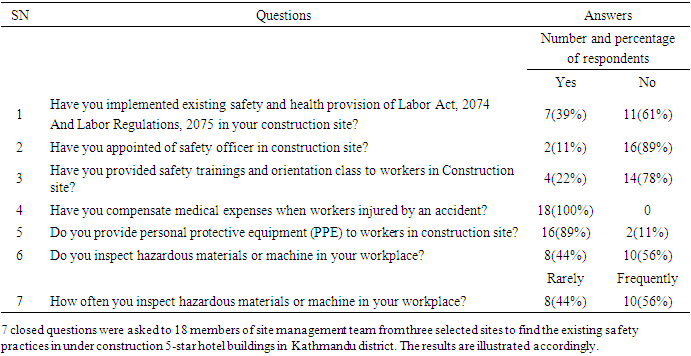 |
| |
|
Table 5. Status of working condition of under construction 5-star hotel building in Kathmandu District
 |
| |
|
Table 6. Status of risks, hazards and human error of under construction 5-star hotel building in Kathmandu District
 |
| |
|
Table 7. Status of strategies to minimize risk at under construction 5-star hotel building in Kathmandu District
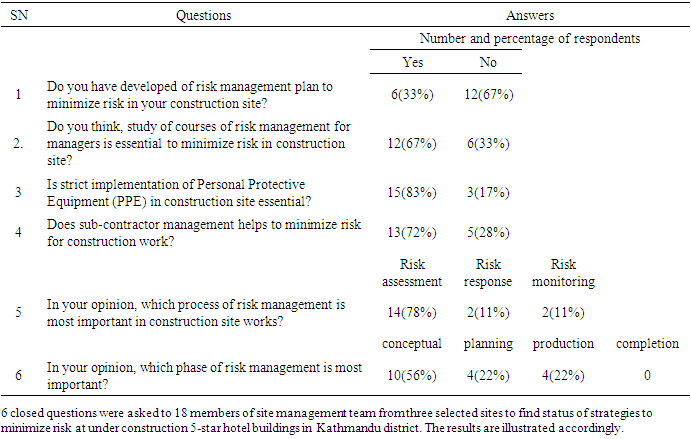 |
| |
|
3.2. Total 18 Questions were Asked to Skilled Workers to Know the Status of Objectives of This Research
Table 8. Status of Existing safety practices in under construction 5-star hotel building in Kathmandu District
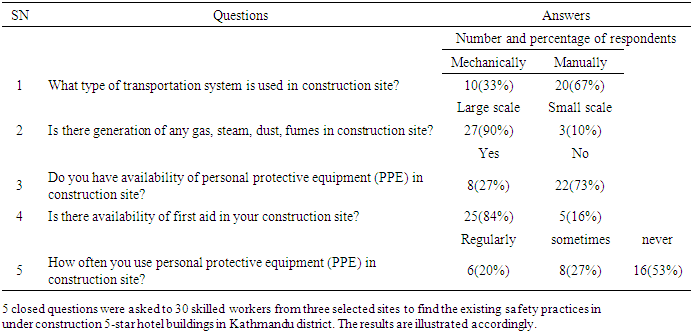 |
| |
|
Table 9. Status of working condition of under construction 5-star hotel building in Kathmandu District
 |
| |
|
Table 10. Status of risks, hazards and human error of under construction 5-star hotel building in Kathmandu District
 |
| |
|
Table 11. Status of strategies to minimize risk at under construction 5-star hotel building in Kathmandu District
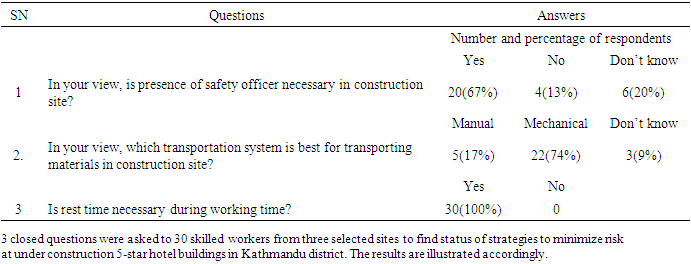 |
| |
|
4. Discussion
(Jannadi, 1996) Identified lack of safety training by managerial team as a factor that can compromise safety while conducting meetings. The main element of safe working environment is the commitment of managing committee. The injury result in suffering the victim, loss of productivity, increase in insurance premiums and possible liability for the involved party in case of not being able to complete project on time. The estimated cost of Shankar group’s Hilton hotel, which started construction in 2016, was 3.5 billion, which has now increased to 6.683 billion in April 2021 (Bijmandu, 2022). Further owner might have to pay more revenue for increasing project completion date resulting in morale reduction of the work force (J. Hinze, 1988). Risk and safety arise from uncertainty and are generally interpreted as factors which have an adverse effect on the achievement of the project objectives (Smith, 2002). According to International Labor Organization (ILO) estimates, throughout the world there are over 300 million work accidents (both fatal and non-fatal), about 160 million work disease cases every year, and some 2.3 million persons die from work related accidents and diseases. Therefore, Occupational safety and health (OSH) is an effective tool required to bridge the decent work deficit, to increase workers’ overall quality of life, and to promote development of society at all levels (dolidar, 2017). Fine at the rate of NPR 10,000 and maximum of up to NPR 5, 00,000 shall be charged to an employer engaging an employee without providing an appointment letter or employment agreement (Nepal Government, 2017). Where any accident occurs or any person is injured or dies in an accident or suffers from any occupational disease in the workplace, the employer shall give information to the Office immediately. No employer shall employ labors to work more than eight hours a day and forty-eight hours a week. The labors shall be provided with half an hour rest after five hours of continuous work. The employer shall procure make an annual medical insurance of at least one hundred thousand rupees for each labor. The employer shall procure accidental insurance of at least seven hundred thousand rupees covering all kinds of accidents for each labor (Nepal Government, 2017). Making safe environment for work by making appropriate safety and health arrangements at the workplace, provision for the use, operation, storing and transportation of chemical, physical or biological materials or equipment so that it would not adversely affect the safety and health, necessary information, notice and training relating to the safety and health to the labor, necessary training and information in an appropriate language to the labor in relation to the use and operation of the equipment or chemical, physical or biological materials related to the work, proper arrangement for the safe entry and exit from the workplace are the duties of employer (Nepal Government, 2017). The employer shall not collect any fee or charge from a labor in consideration for the provision of any safety related facility or equipment to the labor (Nepal Government, 2017).According to DOLIDAR guidelines, (dolidar, 2017) for each project undertaken by the Contractor there shall be one fulltime safety officer who shall be part of the safety and health committee. There must be one part time and one full time safety officer for the workers ranging from 51-100. Similarly, two part time and one full time safety officer for the workers from 100-200 and two part time and one full time safety officer for more than 200 workers in construction site. According this research result, 61% of site management team have not implemented labor act 2074 and 89% have not appointed safety officer. 78% of site management team have not provided safety trainings to workers and 11% have not provided PPE. There is not any provision of proper lighting system. 44% of site management team rarely inspect hazardous machines in construction site. The facility of clean drinking water, clean toilet, rest time, housekeeping and necessary warning signals on site is found very worse according to result of this research.0.5% budget is committed in bill of quantities for personal protective equipment’s, insurance if contract amount is more than 200 million (dolidar, 2017). Contractors must submit their OSH policy, site safety plan, emergency plan, record of accidents and incidents. The Safety Officer must conduct an in depth investigation into the accident and send copies of the investigation within seven days of the incident to the DTO. Contractors and Sub contracts must ensure that all workers are given proper site specific induction in OSH prior to starting work. Site specific training shall be conducted by the site management and or an authorized representative or the Safety officer. Contractors and Sub contractors shall at all times keep and maintain an adequate supply of suitable personnel protective equipment’s (PPE) which are readily available. Appropriate PPE shall be provided to all workers at no cost. Contractors must ensure that there are illustrated safety signage displayed around the site as deemed necessary. No electrical installation, service or power supply shall be used or connected unless prior approval has been received by the contractors (dolidar, 2017). Construction industry had the third largest share of employment 13.8% (statistics, 2017/2018). Force labor is more prevalent in construction (16%. male and 4.2% female in average) working in construction industry in Nepal (statistics, 2017/2018). Construction industries employing lot of workers but they are not being worry about health and safety (koirala, 2018). It is mandatory for all firms to provide a safe working environment for their workers and subcontractors (koirala, 2018). Compared with the manufacturing sector which averages 60-80 accidents per 1000 workers, construction averages 160-250 accidents per 1000 workers (shrestha, 2021). The results of this research indicates, 67% of site management team have not prepared risk management plan and 33% think that there is not necessity of risk management plan. Similarly, 17% of management team have not implemented use of PPE strictly and 28 % of them think that sub –contractor management do not helps to minimize risk in construction site. Similarly, 22% of management team think that risk response and risk monitoring is more important than risk assessment and 44% of them think that planning and production phase of risk management important than conceptual phase of risk management. These results are very scary. The life of workers are in danger. According to 73% of workers, there is no availability of PPE and 53% of workers never use PPE. According to workers, there is no provision of rest time. According to workers, defective machine, Electric shock, Slip, fall, Strike, Falling of object, Ladder, Slippery workplace, Haphazard electrical live wiring and unearthed machines are the causes of injuries at construction site. According to 13% of workers, safety officer is not necessary.Lack of knowledge about safety procedures, No safety officer, inadequate safety trainings, limited availability of PPE, no emergency plan, no risk management plan, no any records of accidents, partial compensation in case of injuries due to accidents, no adequate warning communication system, poor monitoring from government offices, no strict punishment for exploitation of workers and for avoiding guidelines set by government body are all factors responsible for increasing trend of accidents and very poor condition of construction industry in Nepal. Both management team and workers are responsible for accidents and different risks but management team are most responsible. Contractors have profit motive. Safety issues in construction industry are always a problem and primary concern of the governing bodies. This research provides base for safety management. The aim of the study is to generate the procedure which will boost the safety management at under construction hotel sites in Kathmandu by analyzing the risk factors that hamper the safety performance.
5. Conclusions
The results and discussion of this research indicates that overall status of risk minimization strategy in construction site is not satisfactory. Rate of accidents in construction sites are increasing day by day. Workers do not have proper understanding of exposure to hazards and measures to minimize them. Workers are forced to work full of risk sites. They are unsafe. Contractors are not following safety procedures and health guidelines properly as they have committed before start of project work. They are only focused on their profit rather than risk minimization strategy on their sites. The status of timely inspection and maintenance of hazardous material and machine is found very poor. Similarly, use of manual transportation is found most in construction site which is not good for safety purpose of workers. Not appointing safety officers, inadequate safety trainings, limited availability of PPE, lack of emergency plan, missing risk management plan, no any records of accidents, only partial compensation in case of injuries, inadequate warning communication system, very poor monitoring from government offices, no strict punishment for exploitation of workers and for avoiding, negligence of guidelines set by government body are the main reasons for increasing trend of accidents and very poor condition of construction site. Nepal government is found unable to enforce safety policies, regulations that affect the workers’ health. Commitment for safe working environment is not found satisfactory by contractors.
6. Recommendations
As a recommendation, construction companies and contractors or site management team should focus on all risk management process rather than only risk assessment process. Contractors should appoint safety officers on their sites according to occupational safety and health guidelines provided by DOLIDAR, Nepal government. Contractors should provide safety trainings before starting projects, provide sufficient PPE to workers without any cost. Contractors should manage digital warning information system in construction site. Construction Company should bear all injuries expenses, compensate all expenses in case of death to their families. Contractors should focus on regular inspection of hazardous materials or machines of construction sites. Workers should follow safety rules and regulation during working hours. Government offices and authorized staffs should monitor, supervise the construction sites regularly and should focus for the strict implementation of safety procedures and guidelines. Concerned Government body should punish to Construction Company and contractors when found avoiding or not implementing safety rules and regulations, labor act 2074 and its regulations 2075 in construction sites.
References
| [1] | Bijmandu. (2022, July 20). Bijmandu. Nepal, 3. |
| [2] | Bowen, P. J. (2005). Risk Management in Project Organisations. Australia: University of New south wales press ltd. |
| [3] | Diederichs, C. M. (2004). Risikomanagement und Risiko-controlling. Verlag Vahlen. |
| [4] | Dolidar. (2017). Retrieved from dolidar.gov.np. |
| [5] | J. Hinze, C. P. (1988). Identifying Root Causes of Construction Injuries. Journal of construction Engineering and Management. |
| [6] | Jannadi, M. O. (1996). Factors affecting the safety of the construction industry. Building Research & Information. |
| [7] | koirala, M. P. (2018). Risk Factors in Construction Infrastructures Projects and Safety Engineering Practiced in Nepal. INTERNATIONAL JOURNAL OF ENGINEERING RESEARCH & TECHNOLOGY (IJERT). |
| [8] | Nepal Government, N. (2017, september 4). The Labour Act, 2017. kathmandu, Nepal. |
| [9] | Pun, K. (2015). Occupational Safety and Health in Industrial Sector in Nepal. Nepal: Attribution Non-Commercial (BY-NC). |
| [10] | Puspa Raj Pant, J. P. (2021). The prevention of – and first response to – injuries in Nepal: a review of policies and legislation. Health Research Policy and Systems volume. |
| [11] | Salem, S. A. (2021). Risk Management Strategies in Construction Organizations. The Open Civil Engineering Journal. |
| [12] | Schieg, M. (2006). RISK MANAGEMENT IN CONSTRUCTION PROJECT MANAGEMENT. Journal of Business Economics and Management, 77-83. |
| [13] | Shrestha, U. R. (2021). Utilization of Personal Protective Equipment in Construction Industry of Nepal. |
| [14] | Sileyew, K. J. (2019). cyberspace, Research Design and Methodology. IntechOpen. |
| [15] | Smith, N. J. (2002). Engineering project management. Blackwell science. |
| [16] | Statistics, N. p. (2017/2018). bNLFSIII. NEPAL: Nepal Government. |
| [17] | Z, J. S. (2020). Global injury morbidity and mortality from 1990 to 2017: results from the Global Burden of Disease Study 2017. Western Sydney University Research Collection, Vol. 26, Issue Supp. 1, pp. i96-i114. |



 Where, n = sample size, N = population size and e = margin of error (taken as 10%).
Where, n = sample size, N = population size and e = margin of error (taken as 10%). Abstract
Abstract Reference
Reference Full-Text PDF
Full-Text PDF Full-text HTML
Full-text HTML









